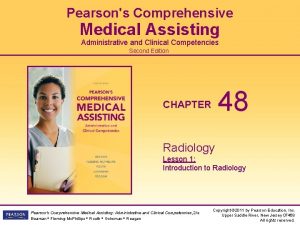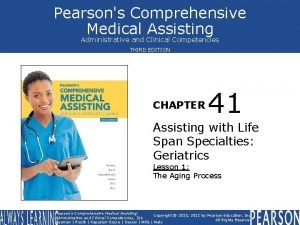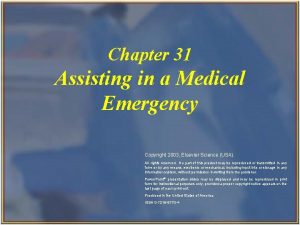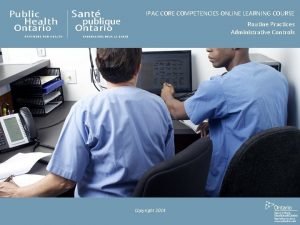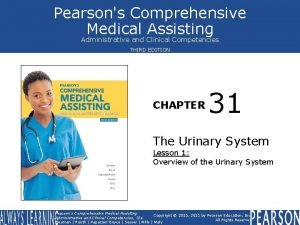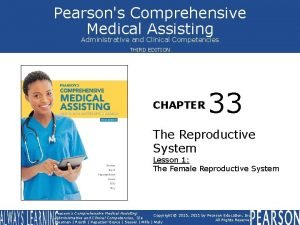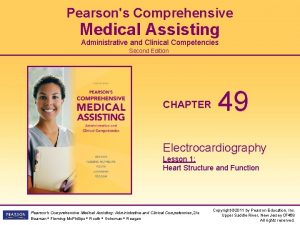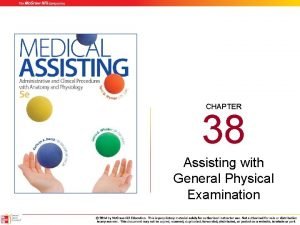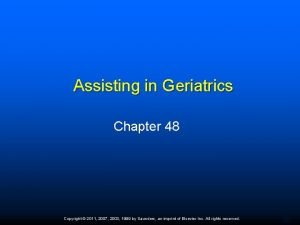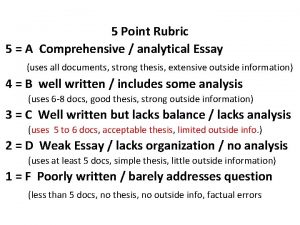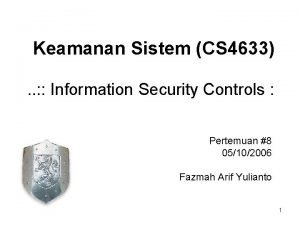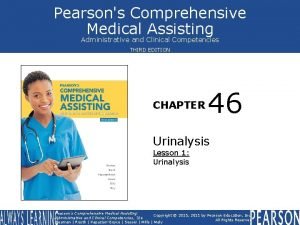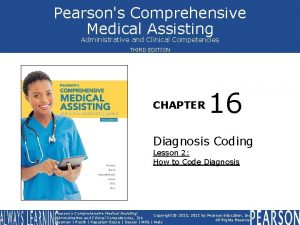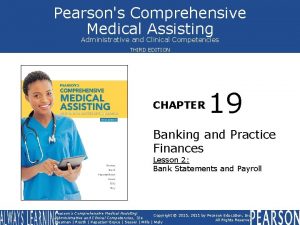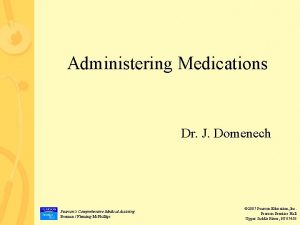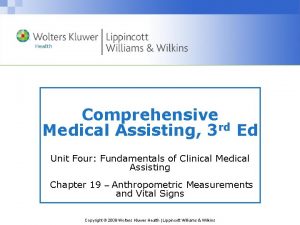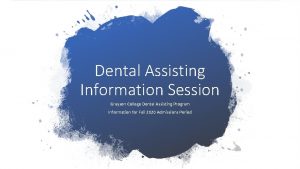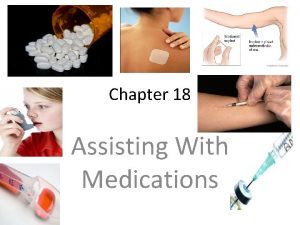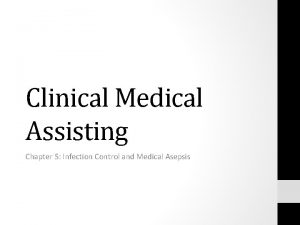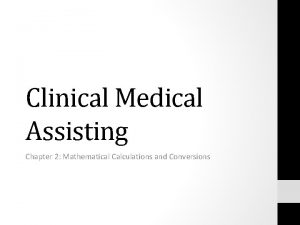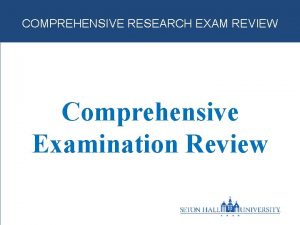Pearsons Comprehensive Medical Assisting Administrative and Clinical Competencies














































- Slides: 46

Pearson's Comprehensive Medical Assisting Administrative and Clinical Competencies Second Edition CHAPTER 35 Vital Signs Lesson 2: Temperature Pearson's Comprehensive Medical Assisting: Administrative and Clinical Competencies, 2/e Beaman • Fleming-Mc. Phillips • Routh • Gohsman • Reagan Copyright © 2011 by Pearson Education, Inc. Upper Saddle River, New Jersey 07458 All rights reserved.

Vital Signs • • • Temperature (T) Pulse (P) Respiration (R) Blood pressure (BP) Pain Pearson's Comprehensive Medical Assisting: Administrative and Clinical Competencies, 2/e Beaman • Fleming-Mc. Phillips • Routh • Gohsman • Reagan Copyright © 2011 by Pearson Education, Inc. Upper Saddle River, New Jersey 07458 All rights reserved.

Taking a Patient’s Temperature: What the Medical Assistant Must Know • How the body balances heat production and loss • What is a normal temperature reading • Factors that influence temperature readings • How to select and use the proper thermometer • How to clean and care for equipment Pearson's Comprehensive Medical Assisting: Administrative and Clinical Competencies, 2/e Beaman • Fleming-Mc. Phillips • Routh • Gohsman • Reagan Copyright © 2011 by Pearson Education, Inc. Upper Saddle River, New Jersey 07458 All rights reserved.

Temperature Values Average body temperature of a healthy person 98. 6°F or 37°C Temperatures can vary by 1°F ( 0. 6°C) during the day Pearson's Comprehensive Medical Assisting: Administrative and Clinical Competencies, 2/e Beaman • Fleming-Mc. Phillips • Routh • Gohsman • Reagan Copyright © 2011 by Pearson Education, Inc. Upper Saddle River, New Jersey 07458 All rights reserved.

Factors Affecting Body Temperature • • • Time of day Age Gender Physical exercise Emotions Pregnancy Environmental changes Infection Drugs Food Pearson's Comprehensive Medical Assisting: Administrative and Clinical Competencies, 2/e Beaman • Fleming-Mc. Phillips • Routh • Gohsman • Reagan Copyright © 2011 by Pearson Education, Inc. Upper Saddle River, New Jersey 07458 All rights reserved.

Fever • Also known as pyrexia • A body temperature above 100. 4°F (38°C) • Indicates that the body is producing greater heat then what is being lost • Indicates that the body is febrile • Hyperpyrexia or hyperthermia develops if temperature exceeds 105. 8°F (41°C) • A temperature above 109. 4°F (43°C) is typically fatal Pearson's Comprehensive Medical Assisting: Administrative and Clinical Competencies, 2/e Beaman • Fleming-Mc. Phillips • Routh • Gohsman • Reagan Copyright © 2011 by Pearson Education, Inc. Upper Saddle River, New Jersey 07458 All rights reserved.

Common Types of Fevers • • Intermittent fever Relapsing fever Constant fever Pearson's Comprehensive Medical Assisting: Administrative and Clinical Competencies, 2/e Beaman • Fleming-Mc. Phillips • Routh • Gohsman • Reagan Copyright © 2011 by Pearson Education, Inc. Upper Saddle River, New Jersey 07458 All rights reserved.

Signs of a Fever • • • Increased heart rate Increased respiratory rate Shivering Chills Sweating If hyperthermia is present symptoms can include cessation of sweating, loss of coordination, drowsiness, and convulsions Pearson's Comprehensive Medical Assisting: Administrative and Clinical Competencies, 2/e Beaman • Fleming-Mc. Phillips • Routh • Gohsman • Reagan Copyright © 2011 by Pearson Education, Inc. Upper Saddle River, New Jersey 07458 All rights reserved.

Hypothermia • Temperature below 97°F (36°C) • Below 93. 2°F (34°C) is fatal • Clinical signs of hypothermia – Decreased pulse and respirations – Pale, waxy, cool skin – Lack of muscle coordination – Drowsiness progressing to coma and death Pearson's Comprehensive Medical Assisting: Administrative and Clinical Competencies, 2/e Beaman • Fleming-Mc. Phillips • Routh • Gohsman • Reagan Copyright © 2011 by Pearson Education, Inc. Upper Saddle River, New Jersey 07458 All rights reserved.

Fahrenheit and Centigrade Thermometers Pearson's Comprehensive Medical Assisting: Administrative and Clinical Competencies, 2/e Beaman • Fleming-Mc. Phillips • Routh • Gohsman • Reagan Copyright © 2011 by Pearson Education, Inc. Upper Saddle River, New Jersey 07458 All rights reserved.

Converting Fahrenheit and Centigrade To convert Fahrenheit to Centigrade Subtract 32 (from °F) and multiply by 5/9 (F° (F − 32) × 5/9 = °C To convert Centigrade to Fahrenheit Multiply °C by 9/5 and add 32 (°C × 9/5) + 32 = °F Pearson's Comprehensive Medical Assisting: Administrative and Clinical Competencies, 2/e Beaman • Fleming-Mc. Phillips • Routh • Gohsman • Reagan Copyright © 2011 by Pearson Education, Inc. Upper Saddle River, New Jersey 07458 All rights reserved.

Sites for Measuring Body Temperature • Oral: For most adults and children who can follow instructions • Rectal: For infants and small children, patients who have had oral surgery, mouthbreathing patients, and unconscious patients • Axillary: For small children • Ear (aural): For small children • Temporal artery: For infants and small children Pearson's Comprehensive Medical Assisting: Administrative and Clinical Competencies, 2/e Beaman • Fleming-Mc. Phillips • Routh • Gohsman • Reagan Copyright © 2011 by Pearson Education, Inc. Upper Saddle River, New Jersey 07458 All rights reserved.

Normal Temperature Values • Oral– 98. 6 F (37 C) • Rectal– 99. 6 F (37. 6 C) • Axillary– 97. 6 F (36. 4 C) • Ear (aural)– 98. 6 F (37 C) • Temporal artery– 98. 6 F (37 C) Pearson's Comprehensive Medical Assisting: Administrative and Clinical Competencies, 2/e Beaman • Fleming-Mc. Phillips • Routh • Gohsman • Reagan Copyright © 2011 by Pearson Education, Inc. Upper Saddle River, New Jersey 07458 All rights reserved.

Critical Thinking Question 1. What might cause you to select one method versus another to take a patient’s temperature? Pearson's Comprehensive Medical Assisting: Administrative and Clinical Competencies, 2/e Beaman • Fleming-Mc. Phillips • Routh • Gohsman • Reagan Copyright © 2011 by Pearson Education, Inc. Upper Saddle River, New Jersey 07458 All rights reserved.

Considerations When Taking an Oral Temperature • Some facilities do not require the designation “O” when documenting this measurement • The patient may not form a tight closure over thermometer – This allows air to enter the mouth and give a false temperature reading • The thermometer is inserted under the tongue on either side of the frenulum linguae Pearson's Comprehensive Medical Assisting: Administrative and Clinical Competencies, 2/e Beaman • Fleming-Mc. Phillips • Routh • Gohsman • Reagan Copyright © 2011 by Pearson Education, Inc. Upper Saddle River, New Jersey 07458 All rights reserved.

Considerations When Taking an Oral Temperature • For an accurate measurement, the patient must be advised not to talk during the procedure • Oral temperature should only be measured if 15 minutes have passed since the patient has taken fluids or smoked Pearson's Comprehensive Medical Assisting: Administrative and Clinical Competencies, 2/e Beaman • Fleming-Mc. Phillips • Routh • Gohsman • Reagan Copyright © 2011 by Pearson Education, Inc. Upper Saddle River, New Jersey 07458 All rights reserved.

When Not to Use the Oral Method • Patients who have had oral surgery, mouth sores, or dyspnea • Uncooperative patients • Patients on oxygen • Infants and small children • Patients with facial paralysis or nasal obstruction Pearson's Comprehensive Medical Assisting: Administrative and Clinical Competencies, 2/e Beaman • Fleming-Mc. Phillips • Routh • Gohsman • Reagan Copyright © 2011 by Pearson Education, Inc. Upper Saddle River, New Jersey 07458 All rights reserved.

Considerations for Taking an Aural Temperature • One of the newer technologies for accurate temperature • Method uses the tympanic membrane area at the end of the external auditory canal for an instantaneous temperature measurement Pearson's Comprehensive Medical Assisting: Administrative and Clinical Competencies, 2/e Beaman • Fleming-Mc. Phillips • Routh • Gohsman • Reagan Copyright © 2011 by Pearson Education, Inc. Upper Saddle River, New Jersey 07458 All rights reserved.

Considerations for Taking an Aural Temperature • Some of the reasons this is an accurate method for temperature measurement are: – The tympanic thermometer provides a closed cavity within the easily accessible ear – Tympanic thermometers are able to detect heat waves in the ear canal and calculate body temperature from the data Pearson's Comprehensive Medical Assisting: Administrative and Clinical Competencies, 2/e Beaman • Fleming-Mc. Phillips • Routh • Gohsman • Reagan Copyright © 2011 by Pearson Education, Inc. Upper Saddle River, New Jersey 07458 All rights reserved.

Considerations for Taking an Axillary Temperature • Axillary temperatures register 1°F (0. 6°C) lower than oral temperatures • The axillary method: – Has proven to be the least accurate of the temperature measurement sites – Is recommended for small children – Is recommended for patients who have had oral surgery, any situation in which the patient may bite the oral thermometer, and mouth-breathing patients – Is affected by perspiration – The underarm area should be dry for an accurate reading Pearson's Comprehensive Medical Assisting: Administrative and Clinical Competencies, 2/e Beaman • Fleming-Mc. Phillips • Routh • Gohsman • Reagan Copyright © 2011 by Pearson Education, Inc. Upper Saddle River, New Jersey 07458 All rights reserved.

Considerations for Taking a Rectal Temperature • The temperature obtained through the rectal method registers 1°F (or 0. 6°C) higher than the oral temperature • Rectal route is: – Considered more reliable than the oral method – Advised for unconscious patients, infants, small children, and mouth-breathing patients – Not recommended when there is a danger of rectal wall perforation Pearson's Comprehensive Medical Assisting: Administrative and Clinical Competencies, 2/e Beaman • Fleming-Mc. Phillips • Routh • Gohsman • Reagan Copyright © 2011 by Pearson Education, Inc. Upper Saddle River, New Jersey 07458 All rights reserved.

Considerations for Taking a Temporal Artery Temperature • A new noninvasive procedure involving a device that measures the temperature over the temporal artery • Temporal artery is located close to the skin surface on the forehead and temple area • When the probe/scanner is passed over the surface of the forehead toward the temple it can read the peak arterial temperature value Pearson's Comprehensive Medical Assisting: Administrative and Clinical Competencies, 2/e Beaman • Fleming-Mc. Phillips • Routh • Gohsman • Reagan Copyright © 2011 by Pearson Education, Inc. Upper Saddle River, New Jersey 07458 All rights reserved.

Types of Thermometers • • Non-mercury glass Electronic Tympanic membrane Disposable Pearson's Comprehensive Medical Assisting: Administrative and Clinical Competencies, 2/e Beaman • Fleming-Mc. Phillips • Routh • Gohsman • Reagan Copyright © 2011 by Pearson Education, Inc. Upper Saddle River, New Jersey 07458 All rights reserved.

Reading a Thermometer Pearson's Comprehensive Medical Assisting: Administrative and Clinical Competencies, 2/e Beaman • Fleming-Mc. Phillips • Routh • Gohsman • Reagan Copyright © 2011 by Pearson Education, Inc. Upper Saddle River, New Jersey 07458 All rights reserved.

Using Thermometer Sheaths Pearson's Comprehensive Medical Assisting: Administrative and Clinical Competencies, 2/e Beaman • Fleming-Mc. Phillips • Routh • Gohsman • Reagan Copyright © 2011 by Pearson Education, Inc. Upper Saddle River, New Jersey 07458 All rights reserved.

Steps in Taking an Oral Temperature Using an Electronic Thermometer Step 5: Remove thermometer probe from the holder. Step 4: Remove thermometer unit from the base and attach the probe (blue for oral). Step 3: Identify the patient and explain the procedure. Step 2: Assemble equipment. Step 1: Perform hand hygiene. Pearson's Comprehensive Medical Assisting: Administrative and Clinical Competencies, 2/e Beaman • Fleming-Mc. Phillips • Routh • Gohsman • Reagan Copyright © 2011 by Pearson Education, Inc. Upper Saddle River, New Jersey 07458 All rights reserved.

Steps in Taking an Oral Temperature Using an Electronic Thermometer Step 10: Return thermometer probe to the storage place. Step 9: Dispose of thermometer tip in a waste container. Step 8: When temperature signal is seen or heard, remove and read the results in the LED window. Step 7: Insert into patient’s mouth on either side of the frenulum linguae and instruct patient to close mouth. Step 6: Insert thermometer probe into the disposable tip box to secure the tip. Pearson's Comprehensive Medical Assisting: Administrative and Clinical Competencies, 2/e Beaman • Fleming-Mc. Phillips • Routh • Gohsman • Reagan Copyright © 2011 by Pearson Education, Inc. Upper Saddle River, New Jersey 07458 All rights reserved.

Steps in Taking an Oral Temperature Using an Electronic Thermometer Step 13: Document the results. Step 12: Perform hand hygiene. Step 11: Replace the unit on the rechargeable base. Pearson's Comprehensive Medical Assisting: Administrative and Clinical Competencies, 2/e Beaman • Fleming-Mc. Phillips • Routh • Gohsman • Reagan Copyright © 2011 by Pearson Education, Inc. Upper Saddle River, New Jersey 07458 All rights reserved.

Steps in Measuring a Rectal Temperature Perform hand hygiene Apply gloves Identify the patient Explain the procedure – If the patient is a child, explain the procedure to both the parent and the child • Instruct the patient to remove appropriate clothing so that the rectal area can be accessed – Provide privacy for the patient • • Pearson's Comprehensive Medical Assisting: Administrative and Clinical Competencies, 2/e Beaman • Fleming-Mc. Phillips • Routh • Gohsman • Reagan Copyright © 2011 by Pearson Education, Inc. Upper Saddle River, New Jersey 07458 All rights reserved.

Steps in Measuring a Rectal Temperature • Assist the patient onto the examining table and cover with a sheet/drape • Instruct the patient to lay on their left side with top leg bent (Sim’s position) Pearson's Comprehensive Medical Assisting: Administrative and Clinical Competencies, 2/e Beaman • Fleming-Mc. Phillips • Routh • Gohsman • Reagan Copyright © 2011 by Pearson Education, Inc. Upper Saddle River, New Jersey 07458 All rights reserved.

Positioning for the Rectal Temperature Pearson's Comprehensive Medical Assisting: Administrative and Clinical Competencies, 2/e Beaman • Fleming-Mc. Phillips • Routh • Gohsman • Reagan Copyright © 2011 by Pearson Education, Inc. Upper Saddle River, New Jersey 07458 All rights reserved.

Steps for Measuring a Rectal Temperature • Remove electronic thermometer from base and place cover on probe • Place a small amount of lubricant on tissue and dip probe into lubricant • With one hand, raise the upper buttock to expose the anus or anal opening • If unable to see the anal opening, ask the patient to bear down slightly – This will expose the opening Pearson's Comprehensive Medical Assisting: Administrative and Clinical Competencies, 2/e Beaman • Fleming-Mc. Phillips • Routh • Gohsman • Reagan Copyright © 2011 by Pearson Education, Inc. Upper Saddle River, New Jersey 07458 All rights reserved.

Steps for Measuring a Rectal Temperature • With the other hand, gently insert lubricated thermometer 1½ inches into the anal canal – Rotating thermometer may make insertion easier Pearson's Comprehensive Medical Assisting: Administrative and Clinical Competencies, 2/e Beaman • Fleming-Mc. Phillips • Routh • Gohsman • Reagan Copyright © 2011 by Pearson Education, Inc. Upper Saddle River, New Jersey 07458 All rights reserved.

Steps for Measuring a Rectal Temperature • Hold thermometer in place until result is signaled • Withdraw thermometer • Dispose of probe cover in a biohazard waste container • Wipe the anus from front to back to remove access lubricant • Assist the patient from the examination table – Instruct the patient to dress and assist if necessary Pearson's Comprehensive Medical Assisting: Administrative and Clinical Competencies, 2/e Beaman • Fleming-Mc. Phillips • Routh • Gohsman • Reagan Copyright © 2011 by Pearson Education, Inc. Upper Saddle River, New Jersey 07458 All rights reserved.

Steps for Measuring a Rectal Temperature • Remove gloves and place them in biohazard waste container • Perform hand hygiene • Record temperature using (R) to indicate rectal reading Pearson's Comprehensive Medical Assisting: Administrative and Clinical Competencies, 2/e Beaman • Fleming-Mc. Phillips • Routh • Gohsman • Reagan Copyright © 2011 by Pearson Education, Inc. Upper Saddle River, New Jersey 07458 All rights reserved.

Steps for Accurately Using the Tympanic Thermometer • Identify the patient – To avoid error, call patient by name and check the name on patient’s record • Explain procedure to patient • Remove thermometer from its base – The display will read “ready” • Attach disposable probe cover to earpiece Pearson's Comprehensive Medical Assisting: Administrative and Clinical Competencies, 2/e Beaman • Fleming-Mc. Phillips • Routh • Gohsman • Reagan Copyright © 2011 by Pearson Education, Inc. Upper Saddle River, New Jersey 07458 All rights reserved.

Steps in Measuring Temperature Using a Tympanic Thermometer • With one hand, gently pull upward on the patient’s outer ear if an adult or pull back and downward if an infant or child • Gently insert the plastic-covered tip of the probe into the ear canal • Press the scan button, which activates thermometer • Observe the temperature reading in the display window Pearson's Comprehensive Medical Assisting: Administrative and Clinical Competencies, 2/e Beaman • Fleming-Mc. Phillips • Routh • Gohsman • Reagan Copyright © 2011 by Pearson Education, Inc. Upper Saddle River, New Jersey 07458 All rights reserved.

Steps in Measuring Temperature Using a Tympanic Thermometer • Gently withdraw thermometer • Eject the used probe cover into a biohazard waste container by pressing the eject button Pearson's Comprehensive Medical Assisting: Administrative and Clinical Competencies, 2/e Beaman • Fleming-Mc. Phillips • Routh • Gohsman • Reagan Copyright © 2011 by Pearson Education, Inc. Upper Saddle River, New Jersey 07458 All rights reserved.

Steps in Measuring Axillary Temperature • Perform hand hygiene • Identify the patient • Explain the procedure – If patient is a child, explain procedure to both the parent and child • Remove electronic thermometer from its base and place cover on probe • Ask the patient to expose the axilla – If patient is an infant or child, ask parent to take the child’s arm out of clothing to expose axilla Pearson's Comprehensive Medical Assisting: Administrative and Clinical Competencies, 2/e Beaman • Fleming-Mc. Phillips • Routh • Gohsman • Reagan Copyright © 2011 by Pearson Education, Inc. Upper Saddle River, New Jersey 07458 All rights reserved.

Steps in Measuring Axillary Temperature • Using a tissue, pat the axilla dry of perspiration • Place the probe with cover into the axillary space Pearson's Comprehensive Medical Assisting: Administrative and Clinical Competencies, 2/e Beaman • Fleming-Mc. Phillips • Routh • Gohsman • Reagan Copyright © 2011 by Pearson Education, Inc. Upper Saddle River, New Jersey 07458 All rights reserved.

Steps for Accurately Obtaining an Axillary Temperature • Ask the patient to remain still and hold the arm tightly next to the body while the temperature registers • When thermometer beeps, remove thermometer and discard the probe in a waste container • The medical assistant can take pulse and respirations while the patient is holding thermometer under the axilla • Return thermometer to storage base Pearson's Comprehensive Medical Assisting: Administrative and Clinical Competencies, 2/e Beaman • Fleming-Mc. Phillips • Routh • Gohsman • Reagan Copyright © 2011 by Pearson Education, Inc. Upper Saddle River, New Jersey 07458 All rights reserved.

Steps for Accurately Obtaining an Axillary Temperature Pearson's Comprehensive Medical Assisting: Administrative and Clinical Competencies, 2/e Beaman • Fleming-Mc. Phillips • Routh • Gohsman • Reagan Copyright © 2011 by Pearson Education, Inc. Upper Saddle River, New Jersey 07458 All rights reserved.

Steps in Using a Chemical Disposable Thermometer • • Identify the patient Explain the procedure Dry the patients forehead Place thermometer strip on the patient’s forehead • Read the correct temperature by reading the color changes – The reading is taken by noting the highest reading among the dots that changed color – It is held in place for about 15 seconds and is read by the color change on the strip Pearson's Comprehensive Medical Assisting: Administrative and Clinical Competencies, 2/e Beaman • Fleming-Mc. Phillips • Routh • Gohsman • Reagan Copyright © 2011 by Pearson Education, Inc. Upper Saddle River, New Jersey 07458 All rights reserved.

Steps to Using a Temporal Artery Thermometer Identify the patient Explain the procedure Brush the patient’s hair aside Place the probe flush on the center of the forehead and depress the red button • Keep the button depressed and slowly slide the probe on the midline across the forehead to the hairline • • Pearson's Comprehensive Medical Assisting: Administrative and Clinical Competencies, 2/e Beaman • Fleming-Mc. Phillips • Routh • Gohsman • Reagan Copyright © 2011 by Pearson Education, Inc. Upper Saddle River, New Jersey 07458 All rights reserved.

Steps to Using a Temporal Artery Thermometer • Lift the probe from the forehead and touch it on the neck just behind the earlobe • Release the button and read the temperature Pearson's Comprehensive Medical Assisting: Administrative and Clinical Competencies, 2/e Beaman • Fleming-Mc. Phillips • Routh • Gohsman • Reagan Copyright © 2011 by Pearson Education, Inc. Upper Saddle River, New Jersey 07458 All rights reserved.

Questions? Pearson's Comprehensive Medical Assisting: Administrative and Clinical Competencies, 2/e Beaman • Fleming-Mc. Phillips • Routh • Gohsman • Reagan Copyright © 2011 by Pearson Education, Inc. Upper Saddle River, New Jersey 07458 All rights reserved.
 Pearson comprehensive medical assisting
Pearson comprehensive medical assisting Chapter 41 assisting in geriatrics
Chapter 41 assisting in geriatrics Medical assistant program rop
Medical assistant program rop Chapter 42 assisting in other medical specialties
Chapter 42 assisting in other medical specialties Chapter 31 assisting in a medical emergency
Chapter 31 assisting in a medical emergency Chapter 42 assisting in other medical specialties
Chapter 42 assisting in other medical specialties Ipac online course
Ipac online course Administrative information system in healthcare
Administrative information system in healthcare Pearsons exam wizard
Pearsons exam wizard Pearsons
Pearsons Pearsons
Pearsons Pearsons
Pearsons Pearsons
Pearsons Pearson's r
Pearson's r Penilaian klinis adalah
Penilaian klinis adalah Assisting in microbiology and immunology
Assisting in microbiology and immunology Arrival and departure list in hotel
Arrival and departure list in hotel Inspection auscultation percussion palpation
Inspection auscultation percussion palpation Chapter 6 general anatomy
Chapter 6 general anatomy Verb advertising
Verb advertising Chapter 5 assisting with the nursing process
Chapter 5 assisting with the nursing process Chapter 41 assisting in geriatrics
Chapter 41 assisting in geriatrics The adaa was formed in 1924 by:
The adaa was formed in 1924 by: Medical terminology learning exercises chapter 1
Medical terminology learning exercises chapter 1 Hepburn osteometric board
Hepburn osteometric board Ptal california medical board
Ptal california medical board Greater baltimore medical center medical records
Greater baltimore medical center medical records Torrance memorial cardiac rehab
Torrance memorial cardiac rehab Cartersville medical center medical records
Cartersville medical center medical records Missouri guidance lessons
Missouri guidance lessons What is an analytical expository essay
What is an analytical expository essay What is continuous and comprehensive evaluation
What is continuous and comprehensive evaluation Conclusion of continuous and comprehensive evaluation
Conclusion of continuous and comprehensive evaluation Missouri comprehensive guidance and counseling program
Missouri comprehensive guidance and counseling program Resources and competencies analysis
Resources and competencies analysis Pmo skills and competencies
Pmo skills and competencies Group dynamics examples
Group dynamics examples Unit standards and competencies diagram
Unit standards and competencies diagram Professional linkages
Professional linkages Competencies and attributes
Competencies and attributes Army fm 6-22
Army fm 6-22 Business analyst competency matrix
Business analyst competency matrix Planning assessing and reporting domain 5
Planning assessing and reporting domain 5 Lrm army
Lrm army Physical technical and administrative controls
Physical technical and administrative controls Chapter 2 administrative and traffic laws
Chapter 2 administrative and traffic laws Administrative and traffic laws
Administrative and traffic laws
